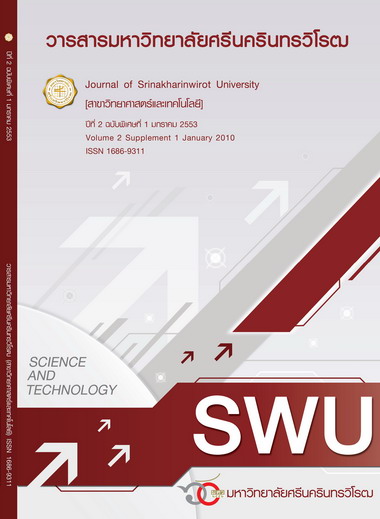การเปรียบเทียบการบีบอัดภาพถ่ายดาวเทียม เพื่อจำแนกรายละเอียดทางภูมิศาสตร์ (COMPARISON OF SATELLITE IMAGE COMPRESSION FOR GEOGRAPHICAL CLASSIFICATION)
Keywords:
Geographical classification, Comparession, Satellite imageAbstract
บทคัดย่อ การศึกษาวิจัยนี้มีวัตถุประสงค์เพื่อศึกษาอัตราการบีบอัดข้อมูลภาพถ่ายดาวเทียมที่เหมาะสมในการจำแนกรายละเอียดทางภูมิศาสตร์เพื่อปรับปรุงแผนที่มูลฐานมาตราส่วน 1:50000 ด้วยเครื่องคอมพิวเตอร์ขนาดเล็กแบบพกพา การศึกษาได้ใช้ข้อมูลภาพถ่ายดาวเทียม Spot5 level 2A MrSID compression ในอัตราบีบอัดที่ระดับ 10 20 30 40 และ 50 เท่า เพื่อหาอัตราบีบอัดที่เหมาะสมโดยพิจารณาจากปัจจัยที่เกี่ยวข้อง คือ ขนาดของข้อมูล ความเร็วในการส่งผ่านข้อมูล ค่ารากที่สองของค่าความคลาดเคลื่อนเฉลี่ยกำลังสอง ค่าอัตราสัญญาณรบกวนเฉลี่ย และทำการประเมินโดยผู้มีประสบการณ์ด้านการใช้ข้อมูลภาพถ่ายดาวเทียมเพื่องานสำรวจข้อมูลแผนที่ การศึกษาพบว่า อัตราการบีบอัดที่มีความเหมาะสมสูงที่สุดในการจำแนกรายละเอียดทางภูมิศาสตร์ตามแนวทางการปรับปรุงแผนที่มูลฐานคืออัตราการบีบอัดที่ระดับ 10 เท่า สำหรับการศึกษาอัตราการบีบอัดที่เหมาะสมแต่ละประเภทของชั้นข้อมูลที่มาจำแนกรายละเอียดทางภูมิศาสตร์ตามแนวทางการปรับปรุงแผนที่ข้อมูลฐานจะพบว่า บริเวณพื้นที่อุตสาหกรรมและพื้นที่บริเวณเขตการบินสามารถบีบอัดได้สูงสุด 30 เท่า บริเวณเส้นทางการคมนาคมทางบก บริเวณข้อมูลอุทกศาสตร์ บริเวณชายฝั่ง และบริเวณเขตพืชพรรณ สามารถบีดอัดได้สูงสุด 20 ส่วนบริเวณพื้นที่สิ่งปลูกสร้างสามารถบีบอัดได้สูงสุด 10 เท่า โดยผลการศึกษาครั้งนี้สามารถนำมาใช้เป็นแนวทางในการทำงานด้านการจำแนกรายละเอียดทางภูมิศาสตร์ เพื่อการปรับปรุงแผนที่มูลฐานได้ในอนาคตต่อไป
The Objective of this study is to select the suitable image-compression ration in order to maintain geographical features for updating the RTSD’s 1:50,000 base map using a pocket mobile computer. A satellite image, SPOT5 level 2A, covering Rayong province was compressed by the MrSID Wavelet compression algorithm at the ratios of 10, 20, 30, 40 and 50 times. The efficiency and accuracy of the examined factors namely, data size, data transfer rate, root mean square errors, and mean square signal to noise ratio were statistically compared. In addition, visual assessments were scored by interpretation experts. The total scores from those characteristics were analyzed. It is found that the optimum compression ratio for geographical classification is 10:1. Besides, the suitable ratio for each land use is obtained. The 30:1 ratio is suitable for the industrial estate and flying zone data. The 20:1 ratio was suitable for transportation, water body, beach and vegetation data. The 10:1 ratio was suitable for building or construction data. The results in this study could be used to update topographic base maps in Thailand.
Downloads
Downloads
Published
How to Cite
Issue
Section
License
Srinakharinwirot University Journal of Sciences and Technology is licensed Under a Creative Commons Attribution-NonCommercial-NoDerivs 4.0 International (CC-BY-NC-ND 4.0) License, Unless Otherwise Stated. Please Read Journal Policies Page for More Information on Open Access, Copyright and Permissions.



